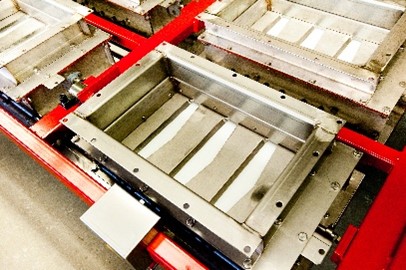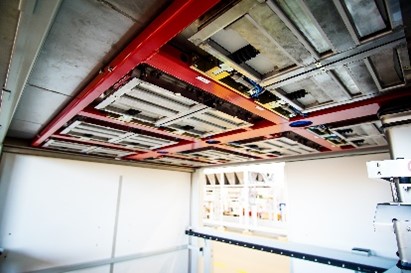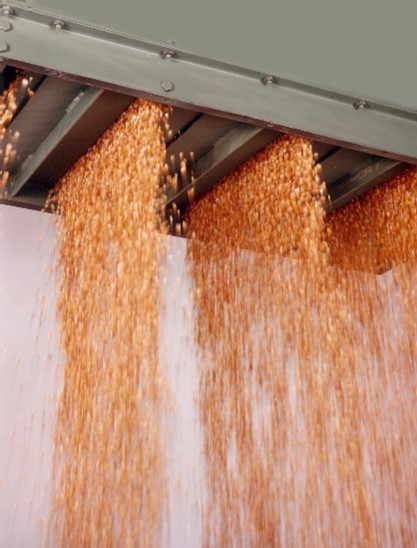It is a challenge to find the most optimal solution for the silo discharge system within a specific process installation. In many cases, it is a question weighing up a dosing slide against a screw feeder. To make a responsible choice, insight into the operation and qualities of both the dosing slide and the screw feeder is required.
Activation
The dosing slide consists of a fixed upper lower grid and an upper grid that moves back and forth during the dosing process. This ensures that the product in the silo is loosened by means of a product-friendly activation. The dosing slide moves the product without transporting it. This means that the product flows straight in a vertical direction, by use of gravity. In contrast to a screw feeder (in which the material is extruded in one direction), no energy is supplied which means no product damage or compaction occurs.
The simple design of the dosing slide makes it a particularly durable discharge system. A dosing slide can be in operation for decades.
Mass flow
The discharge system determines, to a certain extent, the silo's geometry and therefore also the flow image of the product inside the silo. It prefers to not place the discharge system in the middle of the silo funnel, to reduce the risk of product bridging in the silo. A dosing slide generally offers a much larger discharge surface than a screw feeder. The screw feeder's discharge surface is determined by the relatively small diameter and length of the screw itself. The larger discharge surface of the dosing slide ensures an equal discharge flow where mass flow occurs in the silo (the FIFO principle). For a given storage capacity (in case of an equal funnel triangle), less building height is also required.
Dosing range
An important feature of the dosing slide is the enormous dynamic flow range. The ratio between the minimum and maximum flow rate is easily 1:1000 (from grams to kilograms per second), with a dosing accuracy of approximately 2 grams. With a screw feeder, the dynamic flow range is no better than 1:20. An increase in speed not only translates into an increase in capacity, but also into an increase in slippage. It is true that placing a second screw under the main screw reduces the flow to, for example, 1 % of the maximum flow, however, the investment costs for materials and especially the control system will strongly increase. In addition, starting a pull-out screw at low speed requires an extra strong motor with a frequency controller. This extra power is necessary I order to provide the breakaway torque. This requirement does not apply to a dosing slide.
Marketplace
Dosage precision
With a dosing slide, minimum dosage quantities approach 0 grams; with a dosing screw, this quantity is determined by the volume in one turn of the screw. Once the dosing screw's discharge opens a screw compartment, this compartment flows out completely. In addition, there is the risk of the product's continuing to flow (primarily if the product has the tendency to become fluid). It is, of course, possible to install a shut-off after the dosing screw for more precise dosages, but the next dosage then amounts to at least that quantity of material that the shut-off held back. By contrast, a dosing slide closes immediately and completely. The dynamic flow range results in the dosing slide's being able to provide both rapid and precise dosing. With a dosing slide/scale combination, the limiting factor to precise dosage is the scale, not the dosing slide. For this, a weigher-in-weigher can be helpful. This offers the possibility of dosing both 50 g and 100 kg from the same silo in a single batch weighing system with the precision of a few grams within flow ranges up to 5 kg.
Controls
A dosing slide requires a greater investment than a dosing screw, but with the deployment of six or more dosing slides under a silo block, it is cheaper than using six dosing screws with shut-offs. This is because dosing slides (whether this be 4, 6 or even 24 dosing slides) are all powered by one single hydraulic cylinder. This single cylinder activates a framework to which the dosing slides can be linked at will. The power consumption of a dosing slide is extremely low. For example, it is possible to dose up to 50 kg/second with a 3 kW motor. For this same amount of effort, a dosing screw requires at least a 25 kW motor. Furthermore, every dosing screw requires its own power unit and frequency controller.
Discharge characteristics
The controls for a dosing slide are more intelligent and, consequently, more complex than those of a dosing screw (for a screw, flow is proportional to RPM, within certain limits). A dosing slide, however, allows for variation in the percentage of opening, stroke length and frequency. For certain applications, the shape of the vanes can also be adjusted (more or fewer progressive openings). This allows the achievement of optimum discharge properties for the material to be dosed.

Image 1: Dosing slides have a fixed lower grid and upper grid that moves back and forth during the dosing process.

Image 2: A platform of dosing slides is operated by a single drive motor.

Image 3: A dosing slide in operation.
About KSE
Partner in optimizing production processes
Increasing complexity forms the biggest challenge for animal nutrition manufacturers; more recipes, a growing number of ingredients, additions that are difficult to dose and higher quality standards contribute to this trend.
For over 50 years, KSE has been supplying future proof solutions to stay ahead of the trend in the form of modular machinery and smart software that fit together perfectly. We create flexible processing solutions that enable a responsive production process. Automation, accuracy and contamination control are at the basis of our future-proof innovations. Our aim is to not only improve the production process, but also to make a significant contribution to increasing margins and achieving targets.
Together we create the solutions with the best results!
For more information about KSE click HERE.
By KSE
Source: All Pet Food
You could be interested: Innovating together: A new development for the premix pet food industry
About company

About company
Partner in optimizing production processes
Increasing complexity forms the biggest challenge for animal nutrition manufacturers; more recipes, a growing number of ingredients, additions that are difficult to dose and higher quality standards contribute to this trend.
For over 50 years, KSE has been supplying future proof solutions to stay ahead of the trend in the form of modular machinery and smart software that fit together perfectly. We create flexible processing solutions that enable a responsive production process. Automation, accuracy and contamination control are at the basis of our future-proof innovations. Our aim is to not only improve the production process, but also to make a significant contribution to increasing margins and achieving targets.
Together we create the solutions with the best results!

















































